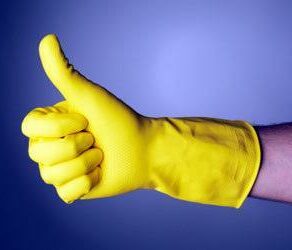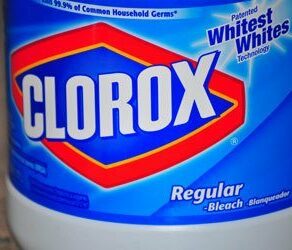Due  to the fumes and harsh chemicals used in cleaning projects, protecting your eyes is not just a good idea, it’s a necessity. There are a variety of options that offer varying degrees of protection. Choose the one that best suits the job at hand.
to the fumes and harsh chemicals used in cleaning projects, protecting your eyes is not just a good idea, it’s a necessity. There are a variety of options that offer varying degrees of protection. Choose the one that best suits the job at hand.
Types of Eye Protection
- Safety Spectacles a.k.a. Safety Glasses – These look most like regular glasses, but many have side shields to protect from any splatters or small particles reaching the eyes. The lenses are made of either toughened glass or polycarbonate. If they need to be worn often, they can even be fitted with prescription lenses to remove the need to wear two pairs of glasses.
- Eye Shields – Eye shields are larger, one piece units that are molded to fit around the face or over prescription glasses. They do not have frames. While they are convenient, comfort can be an issue.
- Goggles – These eyewear units form a seal around the periphery of the face. They are typically held in place by an elastic or adjustable headband. The lenses are typically made of toughened glass or plastic.
Selecting the Right Eye Protection
- When selecting eye protection, look closely at the cleaning products and task at hand. Ask yourself these questions:
- Will there be hazardous fumes? (Yes? Consider goggles that form an airtight seal around your face.)
- Is there a chance of splatter or flying particles? (Yes? Goggles or safety glasses will be best. Choose coverage that is appropriate to your hazard.)
- Can plastic lenses withstand your task – either chemically or mechanically? (No? Choose another material)
- For lighter cleaning jobs with no fumes, safety spectacles are typically sufficient.
- Less is not more in this case. If you are unsure about the level of protection, it is best to prepare for the worst case scenario. While having extra protection will not have any adverse effects, not having enough protection most definitely will.
- Look for eyewear marked with the “CE” label. This insures that they meet the minimal legal requirements.
Proper Use of Protective Eyewear
- If wearing protective eyewear over prescription eyewear, ensure there is a small gap between the two glasses.
- There are many companies that sell different eyewear components. If mixing pieces from several companies, ensure they are compatible for proper fit.
- Ensure that the eyewear fits correctly. This is a necessity for the glasses to be effective. If the particular brand you have does not fit properly, try a different style or different manufacturer.
- Replace cracked or scratched lenses as they can impair your vision and reduce the impact resistance of the eyewear.
What To Do If You Get Something In Your Eye
- Immediately flush the eye with water.
- Do not rub the eyes, especially if small debris have entered the eye. Do not take time to remove contact lenses; the water can be poured directly onto them.
- To flush the eyes, pour cool to lukewarm water onto the affected eye continuously for 20 minutes.
- This can be accomplished by pouring with a cup, placing the eye under a faucet running gently or standing under a shower (do not waste time removing clothing, time is of the essence).
- After several minutes of flushing the eye, it may be necessary to rinse the other eye as well. Sometimes during the rinsing process, the chemicals can be transferred to the other eye.
- After 20 minutes of rinsing, contact the Poison Control Center for further instructions (or have someone else contact them while you are rinsing). Have the bottle of the chemical available to offer information about name, ingredients, etc.
- If necessary, visit the Emergency Room for further treatment.








Leave a reply